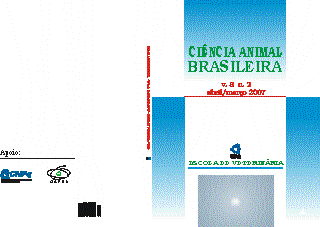IDENTIFICATION OF CORRESPONDENT REGIONS OF THE HEPATIC LOBES IN DOGS BY ULTRASONOGRAPHY
Keywords:
Ultra-som, Cães, Lobos HepáticosAbstract
Ultrasonography is an efficient method for evalu-ating the internal structure of the liver and it gives datum about size, shape and parenchymal disorders. Although the visualization and differentiation of hepatic and portal veins are possible, theirs identification is arduous and the ultrasonographic differentiation of the liver’s lobes has not been described yet. The aim of this study was the ul-trasonographic identification of the canine liver’s lobes, describing its anatomic landmarkers. Ultrasound scans of the liver were applied to 86 adult dogs. Hepatic and por-tal veins examination of 10 normal dogs and 5 dogs with right vein congestion were made. A vynil vascular cast of hepatic and portal veins was obteined. In order to study segmentation, 70 dogs (including 10 cadavers) had pre-determinated liver’s regions examined sonographically, which were certificated by color ink guided injection and further necropsy in the cadavers. The results of the pre-sent research are helpful to determinate the canine liver’s lobes. As most hepatic and portal veins are difficult to be sonographically identified in dogs, segmentation based on the vascular distribution pattern proved to be useless for their determination, althought when identified, these ves-sels are helpful to determinate the lobe.
KEY-WORDS: Anatomy, dogs, live, ultrasound, veins.
Downloads
Downloads
Published
How to Cite
Issue
Section
License
Copyright (c) 2007 Brazilian Animal Science/ Ciência Animal Brasileira

This work is licensed under a Creative Commons Attribution 4.0 International License.
Authors who publish with this journal agree to the following terms:
- Authors retain copyright and grant the journal right of first publication with the work simultaneously licensed under a Creative Commons Attribution License that allows others to share the work with an acknowledgement of the work's authorship and initial publication in this journal.
- Authors are able to enter into separate, additional contractual arrangements for the non-exclusive distribution of the journal's published version of the work (e.g., post it to an institutional repository or publish it in a book), with an acknowledgement of its initial publication in this journal.
- Authors are permitted and encouraged to post their work online (e.g. in institutional repositories or on their website) prior to and during the submission process, as it can lead to productive exchanges, as well as earlier and greater citation of published work (See The Effect of Open Access).




























